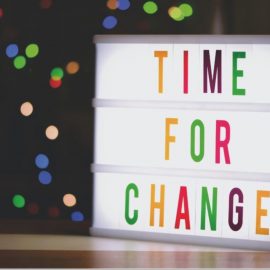
What is mental contrasting? Do you want to turn your dreams into reality instead of just daydreaming about them?
In Rethinking Positive Thinking, Gabriele Oettingen explains what mental contrasting is, presenting it as a powerful strategy that goes beyond positive thinking. By envisioning your desired future and then identifying obstacles in your present reality, you create productive tension and, ultimately, motivation.
Keep reading to discover how mental contrasting can transform your approach to goal-setting and help you overcome the internal barriers that truly hold you back.
What Mental Contrasting Is
Oettingen explains that, to effectively pursue our most important goals and wishes, we need strategies beyond positive fantasies alone. She recommends learning to use a strategy called mental contrasting. We’ll take a closer look at what mental contrasting is and why it works.
(Shortform note: Mental contrasting is a key component of Oettingen’s “Fantasy Realization Theory,” which she began working on in the 1990s. The theory states that, when people contrast their fantasies about a desired future with reflections on present reality, they feel the necessity to act. This perceived need to act raises the question of whether it’s possible for them to turn their present reality into their desired future—and if so, how they can do it. Under this theory, mental contrasting transforms the desired future into something concrete to be achieved, and reality into something to be changed.)
So, what is mental contrasting exactly? Mental contrasting means you still think about achieving your wish, but you don’t stop there. Instead, writes Oettingen, you purposefully imagine the obstacles that stand in between you—in your current reality—and your dream. By making a conscious connection between your present reality and your dream, you can gain clarity on what needs to be done and start to feel motivated. This energizes you to start working to overcome the obstacles you’ve identified and to begin taking productive steps toward achieving your goals.
(Shortform note: Thinkers across fields have noted that figuring out what stands between us and the future we want is a powerful way to motivate ourselves. Essayist and activist Rebecca Solnit (Men Explain Things to Me) contends we have to recognize the possibility for action to work toward our goals, including difficult goals like tackling climate change. Solnit writes that identifying how we want reality to change can push us to take action. We can sustain hope in our ability to make changes (without letting hope undercut our motivation to act) by appreciating the progress we’ve already made. For example, by recognizing the progress we’ve made in cutting carbon pollution, we find hope and sustain our will to make further progress.)
Oettingen explains that, in its most basic form, mental contrasting is a two-step process:
- First, envision your desired future in detail. Allow yourself to experience the positive feelings associated with attaining your wish.
- Then, reflect on your current reality. Thoughtfully identify the key obstacle (or obstacles) preventing you from realizing your desired future.
(Shortform note: Imagining the future we want, and comparing it to our present reality, can be a powerful way to begin to enact change—even the societal changes that activists like Audre Lorde have envisioned and advocated for. Lorde’s work embodied an intersectional approach before that term even existed, addressing not only race but also class, gender, and sexuality. She valued diversity and community as strengths. Lorde challenged the dominant culture’s narrow perspectives and advocated for imagining a future where masculinity, heterosexuality, and whiteness wouldn’t be held up as ideals. She offered a radical vision for social change—one that wouldn’t have been possible without imagination.)
| Is Setting Goals a Uniquely Human Trait? Some scientists think humans aren’t the only animals who set and work toward goals—a notion that contradicts traditional evolutionary theory’s view of organisms as passive products of natural selection. According to some biologists, many organisms exhibit goal-directed behaviors that aren’t fully explained by gene-centric theories of evolution. The “Extended Evolutionary Synthesis” hypothesis sees organisms as capable of directing their own evolution through interactions with their environments. This perspective suggests that we need to acknowledge that other animals and organisms have complex cognitive capabilities and ability to set and work toward goals. Research with animals we know to be highly intelligent is already raising interesting questions about how they handle some of the same decision-making dilemmas we face. While Oettingen emphasizes individual goals, we often have collective goals where it might help to compare our present to the future we want. Scientists are beginning to learn that cetacean species, like whales, also make collective decisions. Researchers aren’t quite sure yet how whales communicate their decisions to one another. But, if they’re like us, they might also find themselves sharing goals but disagreeing on how to best work toward them—a challenge that requires discussion and compromise in group decisions among humans. |
Why Does Mental Contrasting Work?
Oettingen explains that, by juxtaposing the future you want with the obstacles in the present, you can use mental contrasting to create tension, engage both your conscious and non-conscious minds, and fuel your motivation. At the conscious level, mental contrasting helps you clearly see what stands between you and your goal. It changes how you think about setbacks: Instead of seeing them as permanent roadblocks, you start viewing them as challenges you can overcome. This builds your confidence that you can achieve what you set out to do.
Your non-conscious mind—the part of your brain that processes information and influences behavior without your awareness—is also at work during mental contrasting, according to Oettingen. Your brain automatically starts connecting your goal, the obstacles, and the actions you need to take to succeed. She explains that as you practice mental contrasting, you become better at spotting both problems and opportunities, and you react to them more quickly. Interestingly, your brain even adjusts how it views obstacles based on whether your goal is realistic: If the goal is achievable, obstacles appear more threatening (motivating you to overcome them), but if the goal isn’t realistic, those same obstacles appear less daunting (helping you let go of the unrealistic goal and redirect your energy elsewhere).
Crucially, Oettingen explains that mental contrasting works best when you focus on internal barriers—the thoughts, emotions, or habits that hold you back—rather than external circumstances. For example, if you’re training for a marathon, the real obstacles might not be your busy schedule or your lack of access to running trails (which are external circumstances), but rather your tendency to procrastinate, your fear of physical discomfort, or your habit of making excuses (internal barriers). By identifying these deeper, personal obstacles, you can better understand what’s really standing in your way and develop more effective strategies to overcome them.
Continuing the marathon example, through mental contrasting, you might recognize that while you blame your busy schedule, your real obstacle is anxiety about not being “athletic enough” to train with other runners. This awareness, rather than discouraging you, can help you plan practical solutions like starting with solo runs or joining a beginners’ running group. Meanwhile, your non-conscious mind starts automatically noticing opportunities to build up your confidence: You might find yourself naturally taking the stairs to prove to yourself you can handle physical challenges, or becoming more aware of how negative self-talk (“I’m not a real runner”) affects your motivation to train.
(Shortform note: Oettingen focuses on the reasons mental contrasting works as a cognitive strategy for overcoming internal obstacles, but other experts say the strategy also helps you prepare for the emotional experience of encountering these barriers. By visualizing potential roadblocks ahead of time, as Oettingen recommends, you can view them more objectively as impersonal challenges that arise out of human nature rather than as personal failures directly related to you and your character. Anticipating them gives you emotional distance from them: When they arise, you can respond calmly rather than getting derailed. Having this emotional distance—and realizing that you aren’t your thoughts—can help you to persevere.)
Mental contrasting also helps you recognize when a goal might not be the right fit for you right now. For instance, if your dream is to qualify for the Boston Marathon, mental contrasting might reveal that your real barrier isn’t just the training schedule—it’s that you’re not willing to prioritize intensive training over family time. Rather than letting you stay stuck in an endless cycle of dreaming and failing, this honest self-assessment can help you redirect your energy toward a more personally meaningful goal—like running shorter races that let you maintain work-life balance, or finding other ways to stay fit that better align with your values.
| Where There’s a Will, There’s a Way Neuroscientists understand our goals as desired outcomes: outcomes that, if we’re going to achieve them, require us to change our behavior in ways we find new and challenging. They suggest that pursuing the new behaviors that will make our goals happen involves both our cognitive abilities (“the way”) and our motivation (“the will”). Mental contrasting helps us evaluate both. Finding the way: Researchers have found that changing our behavior is difficult because old behaviors have become habits while new ones have not. It takes conscious effort to engage executive functions, like attention and working memory, to figure out how to change our behavior. Mental contrasting helps us assess whether we have the cognitive bandwidth to make these changes right now: When we contrast our dream with reality, we’re forced to consider whether we can realistically dedicate the mental energy needed to form new habits. Finding the will: Even more crucial is motivation. Neuroscientists say that finding the will to pursue a new behavior requires us to work against our brain’s ancient reinforcement learning system, which evolved to incentivize us to repeat rewarding past behaviors. We only feel motivated to change if we perceive value in the new behavior, but our sense of value is strongly shaped by past reinforcement and our present sense of self-identity. This helps explain why mental contrasting is so effective at helping us determine if a goal is right for us: By forcing us to examine our internal barriers, it reveals whether we value the goal enough to overcome our brain’s natural resistance to change. If we can find both the will and the way to make a change, then that’s a sign that a goal is a good fit for our values and ability at the present moment. If we’re lacking one or the other, it might not be the right time or place to pursue a specific goal. |
Once you’ve determined that a goal is right for you, mental contrasting can help you overcome the fears and anxieties that might hold you back. Let’s say you’re afraid of training in public places, which is keeping you from pursuing your running goals. By first envisioning the positive outcome of confidently running in the park, and then acknowledging your social anxiety, mental contrasting can help you approach and confront that fear constructively.
The process will also help you determine whether your fear is justified: If there are legitimate safety concerns about running in certain areas, you’ll recognize that you need to take precautions or find alternative routes. However, if the fear is primarily about feeling judged by others, mental contrasting will help you take steps to overcome it.
Oettingen explains that mental contrasting is most effective for strong, irrational fears that prevent you from taking action. A moderate level of anxiety can actually be beneficial—like the nervous energy that helps you prepare for a race—so mental contrasting is best used when fear is truly holding you back. For example, if your social anxiety about running in public is preventing you from training altogether, mental contrasting can help you develop a plan to start small, perhaps by running during off-hours or finding a supportive running group for beginners.
(Shortform note: While mental contrasting is one way to get through fear or performance anxiety, some experts suggest putting more of an emphasis on being in the moment. Some professional dancers, for instance, focus on calming their body’s stress response using deep breathing, visualization, and meditation, to manage performance anxiety. They say that adopting a growth mindset—focused on learning and improvement, rather than perfection or judgment—can ease the pressure they feel. Lastly, shifting focus away from themselves and onto the shared experience of the present moment with other dancers and with the audience can provide perspective and help them reframe the performance as a gift rather than a test.)






